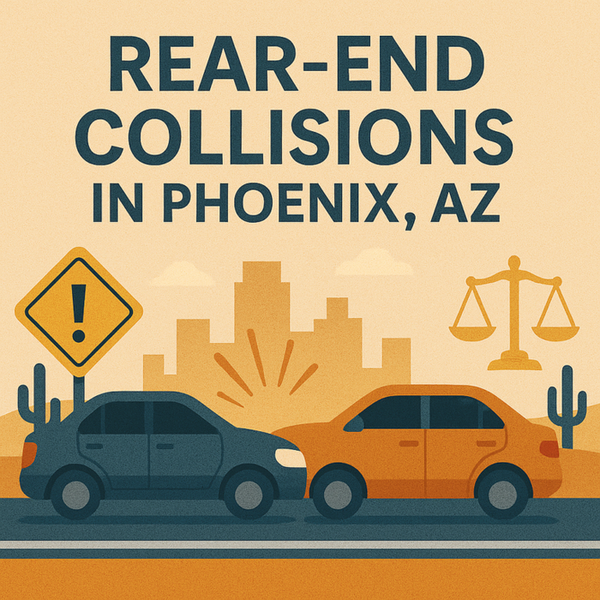Rear-end collisions represent one of the most common types of traffic accidents in Phoenix and throughout Arizona. Despite often being dismissed as minor “fender benders,” these accidents can cause serious injuries, substantial property damage, and complex legal challenges for victims. Understanding the causes, consequences, and options available following a rear-end collision is essential for Phoenix drivers.
The Scope of the Problem: Phoenix Rear-End Collision Statistics
According to the Arizona Department of Transportation (ADOT), Arizona recorded 122,247 total motor vehicle crashes in 2023. Of these accidents, rear-end collisions consistently rank as one of the most common crash types, accounting for approximately 38% of all multi-vehicle crashes statewide.
The statistics paint a concerning picture of traffic safety in Phoenix:
- Approximately 3.58 persons were killed each day on Arizona roads
- One person was killed every 6 hours and 42 minutes
- There were 148 persons injured every day
- One person was injured every 9 minutes and 42 seconds
In Phoenix specifically, congested roadways, distracted driving, and extreme weather conditions create the perfect environment for rear-end collisions. Major corridors like I-10, I-17, and Loop 202 see particularly high rates of these accidents, especially during morning and evening rush hours.
Common Causes of Rear-End Collisions in Phoenix
Several factors contribute to the high frequency of rear-end crashes in the Phoenix metropolitan area:
Distracted Driving
With smartphones becoming increasingly integrated into daily life, distracted driving has emerged as one of the leading causes of rear-end collisions. A driver looking at their phone for just 5 seconds while traveling at 55 mph covers the length of a football field essentially blindfolded.
Following Too Closely
Phoenix’s stop-and-go traffic, particularly during rush hour on major thoroughfares like Camelback Road and the I-10 corridor, creates situations where drivers fail to maintain adequate following distance.
Extreme Weather Conditions
While Phoenix is known for its sunny weather, the summer monsoon season brings sudden, intense rainfall that can create slick roads and reduced visibility. Many drivers fail to adjust their driving behavior for these conditions, leading to rear-end collisions.
Speed-Related Factors
Excessive speed reduces reaction time and increases stopping distance. On Phoenix’s wide, straight roadways like Indian School Road and Bell Road, speeds often exceed posted limits, increasing the risk and severity of rear-end collisions.
Impaired Driving
According to ADOT, alcohol-related crashes accounted for 4.71% of all crashes and 25.73% of all fatal crashes in Arizona in 2023. While not all of these were rear-end collisions, impaired driving significantly increases the risk of all accident types.
Recent Rear-End Collision Incidents in Phoenix
Recent news reports highlight the ongoing issue of serious rear-end collisions in the Phoenix area:
On April 21, 2025, a deadly crash occurred on Loop 202 Red Mountain near 32nd Street in Phoenix. While details were limited, this incident represents one of many serious crashes on Phoenix’s freeway system. Authorities reported that the incident involved impairment, a factor in many serious rear-end collisions.
In another incident reported by AZ Family, a crash on I-10 near 40th Street resulted in one fatality and one injury when a vehicle crashed into a barrier wall. While not a typical rear-end collision, this type of single-vehicle crash often results from drivers swerving to avoid potential rear-end situations.
Common Injuries in Phoenix Rear-End Collisions
The injuries sustained in rear-end collisions can range from minor to catastrophic:
Whiplash and Neck Injuries
The sudden forward-and-backward motion of the head during impact commonly causes soft tissue injuries to the neck. GLG Personal Injury reports that these injuries can take days or even weeks to manifest fully, making immediate medical evaluation crucial even after seemingly minor collisions.
Traumatic Brain Injuries
Even at relatively low speeds, the rapid acceleration and deceleration of a rear-end collision can cause the brain to impact the inside of the skull, resulting in concussions or more severe traumatic brain injuries.
Back and Spinal Injuries
The force of impact in rear-end collisions often transfers through the seat into the occupant’s back, potentially causing herniated discs, spinal fractures, or other serious back injuries.
Facial Injuries
Contact with airbags, the steering wheel, or dashboard can cause facial lacerations, fractures, or dental injuries.
Psychological Trauma
Many rear-end collision victims experience anxiety, depression, or post-traumatic stress disorder, particularly when driving after the accident.
Legal Considerations for Phoenix Rear-End Collision Victims
Under Arizona law, the driver who rear-ends another vehicle is typically presumed to be at fault, as all drivers have a duty to maintain safe following distances and be aware of traffic conditions ahead. However, there are exceptions to this presumption, such as when:
- The lead vehicle makes a sudden, unexpected stop
- The lead vehicle reverses into the following vehicle
- The lead vehicle has non-functioning brake lights
- The lead vehicle cuts off the following vehicle
Arizona follows a “pure comparative negligence” system, meaning that injured parties can recover damages even if they were partially at fault, though their compensation will be reduced by their percentage of fault. This is particularly relevant in complex rear-end collision scenarios involving multiple vehicles or contributing factors.
For comprehensive information about legal options following a rear-end collision in Phoenix, visit GLG’s Car Accident Information Center.
Steps to Take After a Phoenix Rear-End Collision
If you’re involved in a rear-end collision in Phoenix:
- Ensure Safety and Call for Help: Move to a safe location if possible and call 911 to report the accident and request medical assistance if needed.
- Document the Scene: Take photos of vehicle damage, the accident scene, road conditions, and any visible injuries. Note the time, location, and weather conditions.
- Exchange Information: Collect contact and insurance information from all drivers involved, as well as contact information from witnesses.
- Seek Medical Attention: Even if you feel fine initially, some injuries may not manifest symptoms immediately. Medical documentation is also crucial for any potential insurance claims or legal action.
- Report the Accident: File a report with the Phoenix Police Department and notify your insurance company.
- Consult with an Attorney: For personalized guidance on your specific situation, consider speaking with an experienced rear-end collision attorney. GLG’s Phoenix Auto Accident Guide provides valuable resources for this process.
Phoenix Intersection Safety Issues
Arizona’s intersections rank as the third most dangerous in the nation, according to a study by the Simmrin Law Group, with 4.09 intersection wrecks per 100,000 residents—47% higher than the national average. While not all of these are rear-end collisions, intersections present particular risk factors for this type of accident.
The Arizona Department of Transportation (ADOT) has implemented several measures to reduce accident rates at high-risk intersections, including:
- Enhanced signage and signal timing
- Dedicated turn lanes
- Public awareness campaigns
- Targeted enforcement of traffic laws
For up-to-date information on traffic safety initiatives and crash statistics, visit the Arizona Department of Transportation’s Safety page.
Prevention Strategies for Phoenix Drivers
To reduce the risk of being involved in a rear-end collision in Phoenix:
- Maintain a safe following distance (at least 3 seconds in good conditions, more in adverse weather)
- Avoid distractions, particularly cell phone use
- Regularly check brake lights and other vehicle safety features
- Be aware of traffic patterns and anticipate stops
- Adjust driving behavior for weather conditions, particularly during monsoon season
- Use turn signals well in advance of turning or changing lanes
- Stay alert for erratic driving behaviors from other motorists
Phoenix Resources for Accident Victims
The City of Phoenix offers several resources for traffic accident victims:
- Phoenix Police Department: For accident reports and investigation information
- Maricopa County Attorney’s Office Victim Services Division: Provides support services for crime victims, including those injured by impaired drivers
- Arizona Governor’s Office of Highway Safety: Offers educational resources and prevention programs
Conclusion
Rear-end collisions in Phoenix represent a significant safety concern with potentially serious consequences for victims. By understanding the causes, taking appropriate preventive measures, and knowing what steps to take following an accident, Phoenix drivers can better protect themselves and their rights on the road.
If you’ve been involved in a rear-end collision, securing prompt medical attention and experienced legal representation are crucial steps toward ensuring your recovery and fair compensation for your injuries and losses.
References
- Arizona Department of Transportation. (2023). Arizona Motor Vehicle Crash Facts.
- Arizona Governor’s Office of Highway Safety. (2024). Traffic Safety Programs.
- City of Phoenix. (2025). Vision Zero Phoenix.
- AZ Family. (2025, April 21). Deadly crash partially closes Loop 202 at Mini Stack in Phoenix.
- 12News. (2025, April 21). Loop 202 Red Mountain reopens after deadly Phoenix crash.



